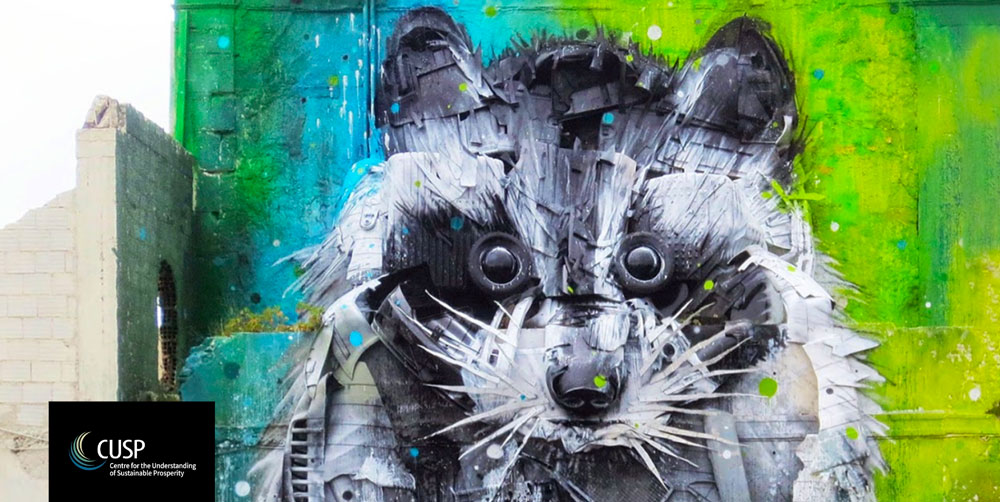Tagging with meaning: good life, racoons, and why hashtags matter
In their recent paper, CUSP researcher Anastasia Loukianov together with Kate Burningham and Tim Jackson explore how the use of hashtags on Instagram shapes the visibility and recognisability of understandings of the good life in the discursive field created by #goodlife on the platform. This blog provides some reflections on the work.
Blog by Anastasia Loukianov

Every day, 95 million posts are shared on Instagram. The platform is a buzzing cacophony of conversations about all topics imaginable: trampolining and philosophy, K-pop and pasta recipes, terminal illness and aquaponics. As researchers who work on the possibility of sustainable and fair futures, it is the conversation on what it means to live well that we were particularly interested in. Indeed, what is understood to be a desirable life plays a crucial role in how people live in the present and the futures they dream of.
Instagram is a hugely popular space for talking about the good life. As of now, over 20 million posts have been shared with the hashtag #goodlife. The latest ones include a picture of a Ferrari, two people sharing tea in a meadow, and a video of a racoon eating ham in a supermarket (yes, really). I know that because I just checked. Hashtags are extremely handy for finding conversations that you want to listen to or participate in. Maybe you feel like your racoon has a good life too and you want others to know about it, so you tag your post #goodlife and #racoon.
But hashtags also allow us to bring different conversations together. What if you think your racoon has a good life andis cute, so you tag your video #goodlife, #racoon, and #cute? Now your racoon is not only part of the conversation about the good life, but also part of that about cuteness. And not only that, but there is now a link between the conversations about living well, the conversation about what is cute, and that about racoons. On average, people use 11 hashtags on a given post, but in theory each post can contain up to 30 hashtags. That’s a lot of links between potentially quite different topics.
Why does that matter? On the scale of one post, it probably doesn’t. But say other people feel the same and post their racoons’ adventures using the hashtags #goodlife, #racoon, and #cute. All of a sudden, the conversations about living well and about cuteness are flooded with racoons. Now racoons become a significant part of how we understand living well and cuteness. So consistent use of a particular set of hashtags makes those understandings more visible and more easily recognisable within given conversations: if you were interested in the conversation about the good life and there was only one person chiming in about their racoon, you’d be likely to overlook it. But a thousand racoons, now that’s harder to miss.
In our recent research, we downloaded a sample (793 to be precise) of Instagram posts tagged #goodlife and decided to map these links between hashtags to see which hashtags were most often used together on these posts. We were hoping to support our identification of different understandings of living well in this way. Do people tend to put #goodlife, #racoon, and #cute together, or is it more something like #goodlife, #travel, #jaccuzzi? Or perhaps #goodlife, #friends, #hangout? Obviously, we might express the same idea using a slightly different set of hashtags (#goodlife, #bf, #date anyone?), which meant that at first our map looked like a giant knitting ball that would have crossed the path of a cat or two. So we spent a lot of time classifying hashtags into semantic categories, which made our map a lot more readable.
For the time being, racoons tend to be fairly rare in conversations about the good life. The dominant themes within that conversation were the good life of the wealthy self-made entrepreneur and that of the glamorous world-traveller. For anyone who has spent any amount of time on Instagram, this is not particularly surprising. What is interesting though is that other understandings, like those that see the good life as spending time with significant others, do exist, but the ways in which hashtags are used on these posts make them less noticeable.
When we look a bit further into patterns of hashtag use, what we find is that this kind of consistency is either achieved via the use of hashtag optimising apps or via skilled and purposeful hashtag selection. Hashtag optimising apps can generate a set of hashtags on any given topic, specially selected to maximise the visibility of one’s post. These apps rely on the Instagram Application Programming Interface (API) to function, which means that the set of hashtags they propose are shaped by the interests which are embedded in the platform’s algorithm. On the other hand, users who have the skills and time to purposively select hashtags tend to be influencers who earn their living from the production of content. In practice, this means that proportionally more of the highly visible understandings tend to be imbued with a commercial flavour.
This is obviously rather disappointing in relation to sustainable and fair living, but the problem doesn’t end there. Research has shown previously that time-rich and financially secure demographics are more likely to have the opportunities to acquire the skills to produce highly visible content. It’s not just that more commercially driven understandings dominate that is the issue, but that not all groups of people are heard to the same extent within that conversation. As our colleague Marit Hammond explains, these inequalities themselves undermine our ability to create understandings which support fairer and more sustainable ways of living by limiting the scope for democratic discussions.
That is a shame because online spaces can be highly creative arenas which support the participation of a large number of people in search for better ways of living. With its 1.2 billion active monthly users, Instagram has enormous potential. But ensuring that different voices can be heard requires rethinking the business logics underpinning the platform. This is of course unlikely to happen any time soon. But in the meantime, judicious hashtag use can help carve out spaces for those understandings of the good life that struggle to shine through under current conditions. And just like that, the space was filled with racoons… or better yet, with friends, families, and significant others, sharing food, propagating strawberry runners, playing music, caring for each other, learning line dancing, and generally doing a little bit more of what we would like to do in a fairer and more sustainable world. And as we carve out spaces for these activities in #goodlife, we just might carve some out in our own lives too, and find kindred spirits who also like to #goodlife #communitygarden #firstharvest along the way.



